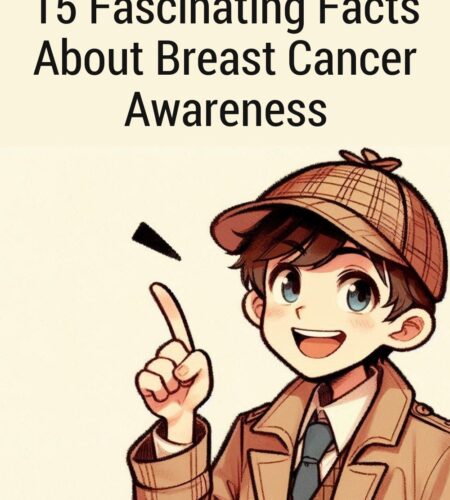Introduction:
Breast Cancer Awareness Month, celebrated every October, is an opportunity for individuals and organizations to raise awareness about breast cancer, honor those who have bravely fought the disease, and support ongoing research for a cure. Breast cancer is the most common cancer among women worldwide, and learning more about it can help save lives. In this article, we will explore 15 fascinating facts about breast cancer awareness that will leave you better informed and inspired to take action.
Fact 1: Breast Cancer is not limited to women
Although breast cancer is predominantly associated with women, men can also develop this disease. While it is rare, men account for about 1% of all breast cancer cases. Just like women, men should remain vigilant about any changes in their breast tissue and seek medical attention if they notice any abnormalities.
Fact 2: Early detection is key
One of the most crucial aspects of breast cancer is early detection. Regular screening tests, such as mammograms, can help detect breast cancer in its early stages when treatment options are generally more successful. Women should discuss with their healthcare providers and determine the appropriate screening schedule based on their age, family history, and other risk factors.
Fact 3: Breast cancer risk factors
Several factors can increase a person’s risk of developing breast cancer. While some risk factors, such as gender and age, are beyond our control, others can be managed. These include maintaining a healthy weight, exercising regularly, limiting alcohol consumption, and not smoking. Being aware of these risk factors empowers individuals to make lifestyle choices that may reduce their chances of developing breast cancer.
Fact 4: Breastfeeding may lower the risk
Breastfeeding not only provides numerous benefits for babies but also offers potential protection against breast cancer for mothers. It is believed that breastfeeding can help reduce a woman’s overall lifetime exposure to estrogen, a hormone that can promote the growth of certain breast cancers. Mothers who breastfeed are encouraged to do so for as long as they can.
Fact 5: Different types of breast cancer
Breast cancer is a complex disease and can be classified into different types based on where it begins in the breast, how it grows, and other characteristics. The most common types are ductal carcinoma in situ (DCIS), invasive ductal carcinoma, and invasive lobular carcinoma. Each type may require different treatment approaches, highlighting the importance of proper diagnosis and personalized care.
Fact 6: Breast cancer can be hereditary
In some cases, breast cancer can be passed down through generations. Mutations in specific genes, such as BRCA1 and BRCA2, significantly increase the risk of developing both breast and ovarian cancers. Genetic counseling and testing can help individuals determine if they carry these gene mutations and make informed decisions regarding their healthcare.
Fact 7: Breast cancer survival rates have improved
Advancements in early detection, treatment options, and increased awareness have led to improved breast cancer survival rates. When detected early, the five-year survival rate for localized breast cancer is about 99%. This encouraging statistic highlights the importance of regular screenings and early intervention.
Fact 8: Breast cancer treatments
Treating breast cancer often involves a combination of different approaches, including surgery, radiation therapy, chemotherapy, targeted therapy, and hormone therapy. The choice of treatment depends on various factors, such as the stage and type of breast cancer, as well as the individual’s overall health. Advances in treatment options continue to provide hope for patients and improve outcomes.
Fact 9: Breast cancer awareness campaigns
Breast Cancer Awareness Month has spurred numerous campaigns worldwide, aiming to raise funds for research, promote education, and support individuals and families affected by breast cancer. The image of a pink ribbon has become widely recognized as a symbol of breast cancer awareness. Through these campaigns, communities come together to advocate for improved healthcare and to encourage early detection.
Fact 10: Support networks are crucial
Facing a breast cancer diagnosis can be overwhelming, but having a strong support network can make a significant difference. Friends, family, support groups, and organizations devoted to breast cancer provide emotional support, share valuable resources, and help individuals navigate their journey from diagnosis to survivorship.
Fact 11: The impact of exercise
Regular physical activity has been linked to a reduced risk of breast cancer. Engaging in moderate-intensity exercise, such as brisk walking or cycling, for at least 150 minutes per week, can significantly contribute to overall health and well-being. Staying active also helps manage stress levels, which can be beneficial for both prevention and recovery.
Fact 12: Not all breast lumps are cancerous
Discovering a lump in the breast can be a cause for concern, but not all lumps are indicative of breast cancer. Many breast lumps turn out to be benign, such as cysts or fibroadenomas. However, it is always crucial to seek medical evaluation for any breast changes to ensure an accurate diagnosis and appropriate treatment, if necessary.
Fact 13: Clinical trials and research
Clinical trials play a vital role in advancing our understanding of breast cancer and developing new treatments. By participating in clinical trials, individuals can contribute to the development of more effective therapies and potentially receive the latest cutting-edge treatments not yet widely available. Clinical trial participation is voluntary and offers hope for improved outcomes.
Fact 14: Life after breast cancer
Surviving breast cancer comes with unique challenges, both physically and emotionally. Many individuals find strength and resilience during their journey, and their experiences inspire others. Supportive care, including counseling, rehabilitation programs, and survivorship plans, helps survivors regain their quality of life and provides ongoing support for long-term survivorship.
Fact 15: Continued research is critical
While significant progress has been made in the fight against breast cancer, there is still much to learn. Continued research and funding are essential to develop more targeted treatments, unravel the complexities of the disease, and ultimately find a cure. Supporting breast cancer research initiatives can bring us closer to a future free from the fear of breast cancer.
Conclusion
Breast cancer awareness is a vital cause that impacts millions of lives worldwide. By understanding the facts surrounding breast cancer, we can raise awareness, promote early detection, and support those affected by the disease. From the significance of early screening to the importance of support networks, each fact contributes to the holistic approach needed to combat breast cancer. Together, let us stand united, spread awareness, and work towards a world where breast cancer is no longer a threat to our loved ones.
Subscribe to our email newsletter to get the latest posts delivered right to your email.





Comments